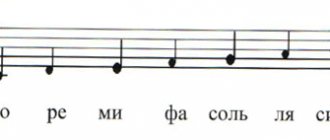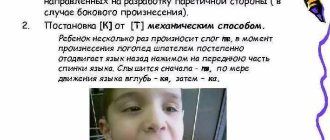Today we are with the letter... or rather, the letter Z is with us.
What do we know about the letter Z? Only that this letter is contained in the Russian alphabet and occupies eighth place in it.
Other languages also have this letter, but not all.
This letter did not exist in either Latin or Greek.
But some languages can boast that thanks to this letter Ж they formed other letters, for example, Ӂ or Җ.
Their spelling is similar, but there are some distinctive signs. One on top, like our Y, the second has a tail at the bottom, similar to Shch.
Such transformations occurred in a number of non-Slavic languages.
The name of the letter in Church Slavonic and Old Slavonic dialects is interesting. This letter is called “live”, as if it orders everyone to live (not to bother).
Why do some children find it difficult to pronounce the sound “Zh”?
There are a number of physiological reasons why some children find it difficult to pronounce the sound “Zh”:
- Pathologies of the structure of the jaws leading to the formation of malocclusion. Among them are progeny (the lower jaw protrudes forward), prognathia (the upper jaw protrudes forward). A closed bite can also lead to a violation of sound pronunciation, when when the jaws are closed, the lower teeth are invisible, that is, they are completely covered by the upper ones.
- Incorrect functioning of the tongue muscle. Here, excessive tension in the back of the tongue and lethargy in the front are noted.
- Hearing problems. This may be a general hearing loss or a disorder of phonemic (sound) hearing.
- Pathologies of the vocal cords.
In addition to physiological ones, there are also external reasons that can influence the formation of the erroneous sound pronunciation “F”. Among them:
- spelling mistakes of others. If one of your relatives or friends pronounces this sound incorrectly, there is a high probability that the child will pronounce it the same way. For example, in kindergarten, children often adopt speech defects from each other;
- repetition by adults of incorrectly spoken words. Many parents, instead of correcting erroneous pronunciation, begin to jokingly repeat what the child said. As a result, the child does not see his mistakes, but only notices the emotion of adults after what he says. This leads to further problems with sound pronunciation.
What else do you need to know
Only a ticket with an error in personal data can be reissued. If you need to change the route, passenger or flight time to a later one, you must return the ticket and buy a new one. More information about reissuing tickets
If, when purchasing a ticket, the date of birth is incorrectly indicated and this affects the cost of the ticket - for example, an adult bought a ticket at a child's fare - then in addition to the fee for reissuing the ticket, the passenger will have to pay the difference to the conductor or at the ticket office.
If the wrong ticket fare is selected (schoolchild, Junior, Senior), then the ticket cannot be reissued - only return it and buy a new one.
Articulation of the sound "Zh"
- The lips should be slightly elongated and rounded outward.
- The front teeth of the upper and lower jaws practically touch with sharp parts, the upper jaw is slightly in front of the lower jaw.
- The tongue is cup-shaped, the lateral edges rest against the molars of the upper jaw. The tip of the tongue vibrates slightly behind the upper front teeth, almost resting on the hard palate.
Breathing should be as follows: the air flow is strong and even. At the same time, the cheeks are deflated and adjacent to the teeth.
When reproducing the sound “F”, it is very important to pay great attention to the voice; it should sound loud and the vocal cords should vibrate.
General recommendations for parents
If a child has problems with the sound pronunciation of “F,” parents are most often able to correct the situation themselves. General recommendations for correcting the defect will be as follows:
- When a baby says words incorrectly, even if this happens in the first years of developing speech skills (1.5-3.5 years), he must be corrected, but in a gentle manner. At the same time, it is important to explain why it is better to speak correctly: the child must understand that comments are made to him for his own good.
- Under no circumstances should you repeat incorrectly spoken words after your child, even when he speaks very funny. And if this does happen, you need to explain to him that it was a joke, and then point out the mistake and explain how to speak correctly.
- It is necessary to include words containing the letter “F” more often in your speech. It is important to pronounce them clearly, without mistakes. And ask the child more questions, the answer words to which presuppose the presence of this letter in the composition.
If exercises for a long time do not give the desired effect, you should seek help from a specialist.
Basic principles of transliteration
The phonetics of the English language is in general similar to the phonetics of the Russian language. And in most cases, there are no problems with transliteration, because approximately half of Russian letters are transferred into English quite easily and without variations. For example , Bb - Bb, Pp - Pp, Ff - Ff . But there are also differences, because many Russian sounds, such as “Ch-Shch”, “Zh-Sh”, etc., have no analogues in the English alphabet. And this is not surprising, because the English alphabet consists of 26 letters, and the Russian one - of 33. Unfortunately, it should be noted that there is no single transliteration system; there are different opinions and disagreements on this issue.
At the moment, there are several GOSTs (for example, GOST 7.79-2000, GOST R 52535.1-2006) and even two ISO standards (ISO 9:1995, ISO/R 9-1968), which are used when filling out various international forms, questionnaires, documentation (foreign passport, driver’s license, etc.) and are used for transliteration of the Russian alphabet. What is noteworthy is that the use of a certain system is prescribed by the organization that carries out the transliteration.
So, how to write the letter “F” in English .
According to GOST 7.79-2000 (functioning in the Russian Federation since 2002), the letter “Zh” in Latin can be written in two ways:
- with diacritic symbol - ž.
- by connecting Latin letters - ZH, zh.
According to GOST R 52535.1-2006, the letter “Zh” is also written in Latin letters - ZH, zh.
Techniques for practicing the sound “Zh” with children
Work to correct a child’s erroneous pronunciation of the sound “Zh” should take place in several stages:
- Observing his pronunciation and searching for the source of the defect.
- Choosing a working method.
- Practicing correct pronunciation.
- Automation of acquired skills.
Observation process
The first step in working with incorrect speech should always be observing the child’s pronunciation. It is very important to determine what is the reason for the incorrect sound of “F”. There are several variants of its erroneous pronunciation:
- swallowing the sound “Zh”;
- replacement with “B” - labiodental parasigmatism;
- pronunciation "G" - nasal sigmatism;
- “D” instead of “F” - paradental parasigmatism;
- replacement with “Ш” or “З” - hissing and whistling parasigmatism.
The parent should monitor the baby’s articulation and breathing when pronouncing the sound. Once the cause is determined, it is much easier to correct the defect. So, for example, replacement with other sounds is most often a consequence of incorrect articulation - which means, first of all, the emphasis should be on its correction.
Sometimes the child directs the air stream incorrectly - this can be seen by puffy cheeks or a weak air flow - then in addition to the articulatory component, breathing exercises must be included.
If your baby is unable to reproduce sonority, you need to train your vocal cords.
Techniques for practicing sound with children: choosing a technique
There are several methods for practicing the sound “Zh”: articulatory, respiratory, imitative, technical, sound transition method and mixed.
Articulation method
It is based on training the muscles of the articulatory apparatus using a set of exercises. Includes the following exercises:
- lips “proboscis” - slightly elongated, rounded outward;
- tongue “cup” - the edges of the tongue should touch the upper teeth, and the middle should be concave;
- “painting” - the spread out, uncompressed tongue moves from the upper teeth across the palate and back;
- “washed your lips, brushed your teeth” - lick your upper lip with your tongue, outside and inside.
If desired, you can also conduct a general set of speech therapy articulation exercises.
Breathing method
If the problem is detected precisely in improper breathing, then the following exercises must be performed:
- “Ribbon” - stretch your lips with a “tube” or “proboscis” and blow onto a light ribbon, which is held in front of your face by one edge at the top. The stream of blown air must be strong - the ribbon rises under its action. The cheeks do not puff out.
- “Autumn leaf” - place a small dried leaf of wood or ordinary paper on your hand. Blow on it in the same way as in the previous exercise so that it flies off your hand.
- “Geyser” - place a straw in a glass of water. Blow into it and admire the bubbles that appear.
Imitative method
It involves connecting a complex of all the child’s senses. The baby looks at the adult, hears the pronunciation of the sound, sees the articulation, catches the movement of the muscles, and then imitates what he saw and heard.
This is how they show the pronunciation of the sound “Zh”:
- articulation – lips “proboscis”, tongue “cup”, teeth “fence”;
- breathing - inhale deeply through your nose, then exhale forcefully but evenly through your mouth;
- voice - the ringing is felt by the hand on the throat - vibration is felt.
Adviсe:
- The adult pronounces the sound clearly, focusing the student’s attention on all the elements that form the sound.
- The student repeats it separately, and not simultaneously with the adult. At the same time, he must listen to himself, developing phonemic hearing.
- It is better to do the exercise in front of a mirror so that the student can see himself in moments of incorrect and correct pronunciation.
Method of transition from other sounds
This is one of the most effective and fastest methods. Certain sounds of the Russian language correspond or are similar to others in articulation. Using this analogy, you can teach a child to pronounce a sound using another that comes easily to him.
Examples for "F":
- correspondence “SH” - their articulation is absolutely the same. The difference in pronunciation is only one thing: “Zh” is voiced, and “Sh” is unvoiced. If a student speaks the sound “Sh” well, then when teaching it is worth relying on it - you need to connect your voice to its pronunciation. In this case, it is important to focus the child’s attention on the vibration of the vocal cords during a voiced sound and its absence when pronouncing a deaf sound. To do this, during classes you need to put your hand on your neck.
- movement from "N" to "W". Often, students who cannot pronounce the sound “Zh” also have problems pronouncing the corresponding hissing “Sh”. In this case, you first need to learn to say “Sh”, and then move on to “F”. If the child clearly pronounces “S”, then you can lead him to the correct “SH” in this way: the child says the letter “S” or the syllable “SA” in a drawn out manner and gradually moves the tongue from the interdental gap upward until the sound “SH” or “SHA” is obtained "respectively (to the upper sky).
- transition from "R". The articulation of the sound “R” is also similar to “Zh”. Only in the situation with “P” the lips are less extended forward, and there is still vibration. When the baby pronounces “R”, you need to gently press the lower surface of the tongue with a cotton swab, stopping the vibration. At this moment, the child should stretch out his lips and, pronouncing a new sound, try to remember it.
Technical method
The technical method involves the use of additional speech therapy instruments (spatulas, probes). Children are often afraid of these devices. Therefore, they are usually used as a last resort when other methods do not help. You can also use cotton swabs or spoons as auxiliary tools.
Mixed method
Includes a mixture of several or all of these methods.
Consonant sound [zh], letters Zh, zh
One day three bees gathered and began to buzz about who would out-buzz whom.
─ w-w. - One bee buzzed.
─ w-w-w. - Another bee buzzed.
─ w-w-w-w. – The third bee buzzed, taking more air into its mouth.
Then the sun came down and spoke.
─ Listen, bees, you better go and work.
─ We don’t know how to work, we are still small and still learning.
─What can you do?
─ Buzz. Ha ha ha.
─ Good. If you are so smart, answer me this question: what letters represent the sound you just made?
─ M... We don't know.
─ Doesn’t anyone know? Oh, you students. You don’t want to work or study.
─ Sunny, tell us about the letters, otherwise it’s somehow embarrassing.
─ Okay, listen.
Sound [w]
, which you just said, can be indicated in writing by a capital
letter Zh
and a small
letter zh
.
For example, in the word snowflake the sound [zh]
is indicated by a small
letter zh
, and in the word Zhenya it is a large letter.
Sound [w]
is
a consonant sound
.
Let's all pronounce the sound [zh]
.
You see, the tongue and teeth prevent air from passing freely in the mouth, and a kind of obstruction arises.
Sound [w]
pronounced firmly in words. For example, beetle, puddle, Zhanna. That's why they say that this sound is hard.
Consonant sounds can sound voiced or dull. Sound [zh-zh-zh]
It sounds resonant, that’s why they say that this sound is resonant.
Capital letter Z
and the small
letter z
are letters that tell us that we must pronounce
a voiced paired sound [z]
.
Sometimes, in some words, instead of the sound [zh],
we pronounce and hear
the sounds [w]
.
For example, in the word spoon. In the middle of the word we hear a hard consonant sound [w]
, and we write
the letter w
.
In this case, in order not to get confused about which letter should be written w
or
w
, we will change the word so that after
the letter w
there is a vowel letter.
For example, a spoon. In the middle of the word we clearly hear the sound [zh]
, which means we will write
the letter zh
.
Now, we'll see how these letters are written.
Letter Z
can be big and small.
─ Yes, a good letter. She looks like a beetle.
─ Yes. One day I look from the sky and see the letter w
lies in the grass.
A letter suddenly ran, it turned out to be a beetle.
─ Well, bees. Now I'll see what you've learned.
the letter z are hidden in the flowers and leaves.
.
Please find all the words with the letter z
.
─ But I don’t know how to read.
─ To find the letter w
in words, it is not necessary to be able to read.
You remember what the letter z
?
─ Well, yes, we remembered.
─ Then complete the task, and then we’ll check it.
─ Well, show me what you did?
─ Can I go first, that’s my word.
letters in it
: first and in the middle.
─ But that’s not correct. I will now read your word: doll. You hear the sound here [f]
?
─ No.
─ And I don’t hear, that means the letters z
not here either. You found the letter k.
Well, who's next?
─ Here is my word.
─ This is the word friendship. It has the sound
[zh]
and
the letter zh
, which are in the middle of the word.
─ Now it’s my turn.
─ So, this is the word Zhenya. This is a boy's or girl's name, so it is written with a capital letter.
.
─ And here’s another one.
─ Wow, well done, you even found a sentence that starts with a capital letter w
. Well, show me, what else do you have there?
─ This is the Firebird from a fairy tale. My mother read to me.
─ That's right. The name of this bird also has the sound [zh]
, which is denoted in writing by a capital
letter Zh
.
─ Yes, you turned out to be the smartest of all.
And you, friends, remember that study and work are the most important things in life.
So we got acquainted with the hard consonant sound [zh]
, which in writing is denoted by a capital
letter Ж
and a small
letter
Ж.
Since then, on the lawn, above the chamomile
The bee flies, collects honey and sings a song:
Zhu-zhu-zhu, zhu-zhu-zhu, I'm friends with everyone
And I’ll tell everyone about the letters.







